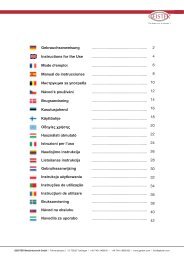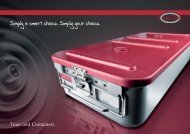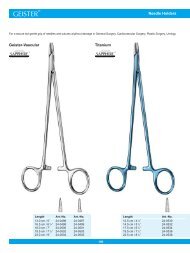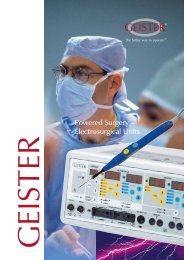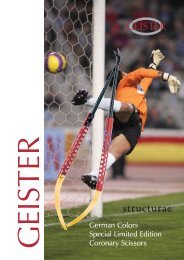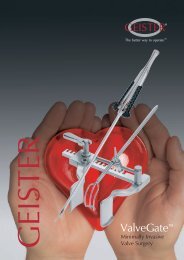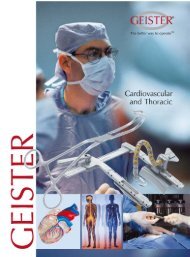Surgical Instruments - Geister
Surgical Instruments - Geister
Surgical Instruments - Geister
You also want an ePaper? Increase the reach of your titles
YUMPU automatically turns print PDFs into web optimized ePapers that Google loves.
Directions for the Use<br />
<strong>Surgical</strong> <strong>Instruments</strong><br />
First use of new <strong>Surgical</strong> <strong>Instruments</strong><br />
Every instrument must be cleaned and sterilised before it is used.<br />
Medizintechnik GmbH<br />
Föhrenstraße 2<br />
78532 Tuttlingen / Germany<br />
Tel.: +49-7461-96624-0<br />
FAX: +49-7461-96624-22<br />
e-Mail: info@geister.com<br />
Caution<br />
The instruments may only be used for their intended purpose in the surgical specialties by educated and<br />
qualified personal. The surgeon shall be responsible for the propper selection of the instruments for each<br />
application, for obtaining the appropriate training, knowledge and experience, and for their operative use.<br />
<strong>Geister</strong> Medizintechnik GmbH as manufacturer and seller cannot accept any liability for immediate or<br />
consequential damages caused by inappropriate application and use or by inappropriate sterilisation and<br />
maintenance of the instruments.<br />
If instruments are repaired by any companies or persons not authorized by <strong>Geister</strong> Medizintechnik GmbH to<br />
do so, all warranties are becoming null and void.<br />
Carefully examine each surgical instrument for breaks, cracks, deformations and malfunctions before use. It<br />
is especially essential to check areas such as blades, points, ends, stops and snaps as well as movable<br />
parts. <strong>Instruments</strong> that are worn out, corroded, deformed, porous or damaged in any other way must be<br />
sorted out.<br />
Storage<br />
<strong>Instruments</strong> should be stored in a clean, dry, moisture free area. <strong>Instruments</strong> should be stored individually in<br />
their shipping carton or in a protective tray with partitions. Protect tips, edges etc. with tubing, protecting<br />
caps, gauze or fabric. Make sure that no chemicals are close to or in the storage area.<br />
Used materials<br />
Stainless steel as per DIN EN ISO 7153-1<br />
Pure titanium as per DIN ISO 5832-2<br />
Titanium alloys as per DIN ISO 5832-3<br />
Light metal (Aluminium) as per DIN EN 573-3<br />
Steel instruments<br />
The high-grade steels (rustproof, stainless) that are used for manufacturing surgical instruments create due<br />
to the chemical composition specific passive layers as protective surfaces. Those steels however are only to<br />
a certain extent resistant against attacks of chloride ions and aggressive waters! Chloride ions mainly cause<br />
pitting, but can also cause stress corrosion cracking. The greatest danger is water in which considerable<br />
quantities of common salts (sodium chloride) are dissolved.<br />
Titanium instruments<br />
<strong>Instruments</strong> made from pure titanium or titanium alloy can be handled and treated like steel instruments and<br />
no special precautions gave to be taken. Some titanium instruments are completely or partially anodised in<br />
blue color for identification purpose.<br />
Aluminium instruments<br />
Only non-alkaline, neutral cleaning agents in combination with fully demineralized water must be<br />
used. Otherwise damages to the anodized surface are possible. Alkaline cleaning causes marks and color<br />
fading on the surface particularly of colored instruments already after just a few cycles.<br />
In addition to the endeavours undertaken by the manufacturer with regards to the selection of the proper<br />
materials and its careful processing, the user has to ensure continuous and proper care of the surgical<br />
instruments as well as proper preparation, cleaning and sterilisation.<br />
Dateiname mit Änderungsstand Erstellt / Geändert am: Bearbeitet von: Seite<br />
Directions for the Use <strong>Surgical</strong> <strong>Instruments</strong> EN I.doc 02.09.08 cg / jw 1 von 4
Procedure: Automated Cleaning Process<br />
Products: <strong>Instruments</strong> for Cardiovascular Surgery<br />
Microsurgical <strong>Instruments</strong><br />
Tissue Forceps<br />
Bulldog Clamps<br />
Atraumatic Clamps<br />
Hemostatic and Dissecting Forceps<br />
Needle Holders<br />
Tourniquets, Suture Catchers, Vein Strippers<br />
Scissors<br />
Suction Tubes and Needles<br />
Self-retaining Retractors<br />
Hand-held Retractors<br />
Bone <strong>Instruments</strong> and Rongeurs<br />
Bronchoscopes, Mediastinoscopes<br />
Care and Maintenance<br />
ADVICE:<br />
Reprocessing procedures have only limited implications to a surgical instrument.<br />
The limitation of the numbers of reprocessing procedures is therefore determined<br />
by the function / wear of the device.<br />
In case of damage the device should be reprocessed before sending back to the<br />
manufacturer for repair.<br />
Reprocessing Instructions<br />
Preparation at the<br />
Point of<br />
Use:<br />
Remove gross soiling by submerge the instrument into cold water (40°C) as this can cause the fixation of<br />
residua which<br />
may influence the result of the reprocessing process.<br />
Transportation: Safe storage and transportation in a closed container to the reprocessing area to<br />
avoid any damage and contamination to the environment.<br />
Preparation for The devices must be reprocessed in an opened or disassembled state.<br />
Decontamination:<br />
Pre-Cleaning: Immerse the instrument into cold tap water for at least 5 minutes. Dismantle the<br />
instruments If possible and brush under cold tap water until all visible residues are<br />
removed.<br />
Inner lumens, threads and holes are flushed each with a water jet pistol for<br />
minimum 10 seconds in the pulsed mode<br />
Immerse the instrument into an ultrasonic bath with alkaline (enzymatic) detergent<br />
(0,5%) and treat with ultrasonic for 15 minutes at 40°C.<br />
The instrument is taken out of the bath and rinsed with cold tab water again.<br />
Automated Cleaning: A: Put the instruments opened and or, if possible, in a disassembled state on an<br />
instrument tray. Put the tray on an instrument rack in the washer disinfector and<br />
start the cycle:<br />
B: Keyhole Surgery <strong>Instruments</strong>: Put the instruments opened and or, if possible, in<br />
a disassembled state on a special key hole surgery rack. Not suitable instruments<br />
are placed on an instrument tray below and start the cycle:<br />
1. 1 min. pre-cleaning with cold water<br />
2. draining<br />
3. 3 min. pre-cleaning with cold water<br />
4. draining<br />
5. 5 min cleaning at 55°C, 45°C with 0,5 % alcaline, enzymatic detergent (if<br />
enzymatic detergent is used the cleaning temperature is 45°C).<br />
6. draining<br />
7. 3 min neutralisation with warm water (>40°C) and neutralizer<br />
8. draining<br />
9. 2 min rinse with warm water (>40°C)<br />
10. draining<br />
Disinfection: Automated Thermal Disinfection in washer/disinfector under consideration of<br />
national requirements in regards to A0-Value (see ISO 15883)<br />
Dateiname mit Änderungsstand Erstellt / Geändert am: Bearbeitet von: Seite<br />
Directions for the Use <strong>Surgical</strong> <strong>Instruments</strong> EN I.doc 02.09.08 cg / jw 2 von 4
Drying: Drying of outside of instrument through drying cycle of washer/disinfector.<br />
If needed, additional manual drying can be performed through lint free towel.<br />
Insufflate cavities of instruments by using sterile compressed air.<br />
Functional Testing,<br />
Maintenance:<br />
Visual inspection for cleanliness, assembling and functional testing according to<br />
instructions of use.<br />
If necessary perform reprocessing process again until the instruments are visibly<br />
clean.<br />
Packaging: Appropriate packaging for sterilization according ISO 11607 and EN 868<br />
Sterilization: Sterilization of instruments by applying a fractionated pre-vacuum process<br />
(according. ISO 13060 / ISO17665) under consideration of the respective country<br />
requirements.<br />
Parameters for the pre-vacuum cycle:<br />
3 prevacuum phases with at least 60 milli bar<br />
Heat up to a minimum sterilization temperature of 132°; maximum temperature<br />
137°C<br />
Minimum Holding time: 3 min<br />
Drying time: minimum 10 min<br />
Storage: Storage of sterilized instruments in a dry, clean and dust free environment at<br />
Reprocessing<br />
validation study<br />
information<br />
modest temperatures of 5°C to 40°C.<br />
The following testing test devices, materials & machines have been used in this<br />
validation study;<br />
Detergent: Neodisher FA; Dr. Weigert; Hamburg<br />
Endozime, Fa. Ruhof (Enzymatic)<br />
Neutralizer: Neodisher Z; Dr. Weigert, Hamburg<br />
Washer / Disinfector: Miele 7735 CD<br />
Instrument Rack: Miele E 327-06<br />
Key Hole Surgery Rack: Miele E 450<br />
Details: Cleaning: Project No 01707011901-2<br />
Sterilization: Project No 13308022609<br />
Additional Instructions:<br />
If the described chemistry and machines are not available, it is the duty of the user to validate his process<br />
It is the duty of the user to ensure that the reprocessing processes including resources, materials and<br />
personnel are capable to<br />
reach the required results. State of the art and often national law requiring these processes and included<br />
resources to be validated<br />
and maintained properly.<br />
When using autoclaves for sterilization of surgical instruments, it has to be strictly ensured that the steam<br />
used is absolutely free of foreign substances such as corrosive particles or dirt to avoid subsequent<br />
corrosion or dirt (scum) deposit. Please observe strictly the instructions for use given by the manufacturers<br />
of autoclaves.<br />
Do not use any damaged instruments.<br />
Hints for the sterilization of the instruments with sterilization container systems<br />
• Use 1 or 2 layer of the OT cloth inside of the sterilization container as a wrap around the basket to<br />
absorb the humidity at the bottom in particular.<br />
• Do not wrap the sterilization container on the outside with paper or textile filters during the sterilization<br />
cycle. This would cover the holes, press the filter inside and does not allow for the steam to move in and<br />
out properly. Also drying is not possible in proper manner.<br />
• Replace singel use paper filters after each and textile filters after 60 cycles.<br />
• A drying cycle time of 20 minutes after autoclave cycles must be observed by all means! It’s not allowed<br />
to skip this dry time, because it’s crucial! After this the sterilization container and the goods should be<br />
quite dry inside. This should be tested.<br />
• Remaining humidity in sterilization container and subsequent storage in this way can cause brownish<br />
discoloration or rust on instruments.<br />
• IMPORTANT! Loading weight of 1/1 sterilization containers shall be not more than 10 kgs! The loading<br />
weight of the smaler sterilization containers shall be appropriate less than the 1/1 sterilization<br />
containers.<br />
Dateiname mit Änderungsstand Erstellt / Geändert am: Bearbeitet von: Seite<br />
Directions for the Use <strong>Surgical</strong> <strong>Instruments</strong> EN I.doc 02.09.08 cg / jw 3 von 4
• For Crutchfield-Jacob contaminationed instruments sometimes the holding time at the sterilization cycle<br />
will be increase to a higher time of 30 min. This is known to cause problems on many instruments. It’s<br />
better to use a proper disinfectant before and use common holding time for instruments.<br />
Equipment and methods used for cleaning, desinfection and sterilization have to be in accordance<br />
with the following standards and recommendations:<br />
EN ISO 17664 Sterilization of medical devices – Information to be provided by the manufacturer<br />
for thr processing of resterilizable devices<br />
EN ISO 17665-1 Sterilization of health care products - Moist heat - Part 1: Requirements for the<br />
development, validation and routine control of a sterilization process for medical<br />
devices<br />
EN ISO 14937 Sterilization of health care products - General requirements for characterization of<br />
a sterilizing agent and the development, validation and routine control of a<br />
sterilization process<br />
EN 285 Sterilization – Steam-sterilizers – Large Sterilizers<br />
EN 13060 Small steam sterilizers<br />
ISO 15883 Washer-disinfectors<br />
DEN 556-1 Sterilization of medical devices – Requirements for medical devices to be<br />
designated “STERILE” – Part 1: Requirements for terminally sterilized medical<br />
devices<br />
EN ISO 11607-1 Packaging for terminally sterilized medical devices - Part 1: Requirements for<br />
materials, sterile barrier systems and packaging systems<br />
EN 868 Packaging materials for terminally sterilized medical devices<br />
DIN EN ISO 11737-1 Sterilization of medical devices - Microbiological methods - Part 1: Determination<br />
of a population of microorganisms on products<br />
DIN EN ISO 11737-2 Sterilization of medical devices - Microbiological methods - Part 2: Tests of sterility<br />
performed in the validation of a sterilization process<br />
DIN 58946-7 Sterilisation; Dampf-Sterilisatoren; Bauliche Anforderungen bei Groß-<br />
Sterilisatoren<br />
Proper Maintenance of <strong>Instruments</strong>, Working group instrument preparation<br />
http://www.a-k-i.org<br />
Maintenance of instruments<br />
Maintenance of surgical instruments means lubrication with physiologically inert instrument oil (acc. to DAB 8<br />
or Ph.Eur. or Usp) particularly of the joints. Make it a basic rule to thoroughly lubricate surgical instruments<br />
prior to checking for function. All movable parts (joints) and cutting blades of scissors have to be lubricated.<br />
This avoids metal abrasion when checking for function. Lubricants used must guarantee, that even after<br />
frequently repeated use a “sticking” of joints through a multiplying effect is avoided.<br />
Dateiname mit Änderungsstand Erstellt / Geändert am: Bearbeitet von: Seite<br />
Directions for the Use <strong>Surgical</strong> <strong>Instruments</strong> EN I.doc 02.09.08 cg / jw 4 von 4



